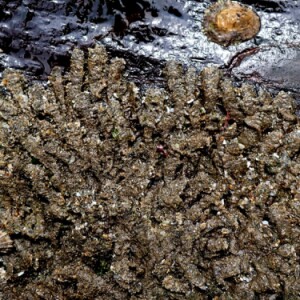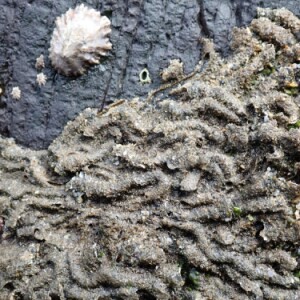Very sustainable housing
"On these shores so violently beaten by the waves, one encounters sometimes behind a large rock, sometimes inside a deep cleft, but also often on some entirely exposed headland, large clods of sand studded with an infinity of small openings half-covered by thin ridges. Each of these clods, which are similar in appearance to beehives, are either villages or dense metropoles. For here live hundreds of cloistered honeycomb worms, the most curious of tube-dwelling annelids that the naturalist may observe." (A. de Quatrefages, 1854.)
These sandy reefs described by the French naturalist above are created by tiny marine worms that build and live in individual tubes made from grains of sand glued together and cemented one upon another in hummocks fastened to the rocks below. It's the apertures of countless tubes that give the honeycomb impression and make the hard structure brittle enough to be crushed by human feet or the pounding of heavy waves. After a few years the whole reef may be dissolved back into the water and new colonies created upon the substructure of the old.
It was a balmy afternoon and I spent an hour or so at the bay, alone save for a few walkers passing by, and another hour picking berries for the wild fruit jelly I make at this time of year.
Extras show the structure of the worm tubes as they fan out along the surface of the rock. And a single comma butterfly glowing like an ember in the sunshine along the coast path.




Comments
Sign in or get an account to comment.


